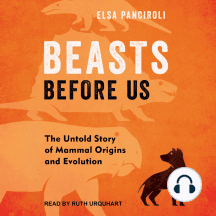For a long time, most of us have had the impression mammals first emerged in the late Cretaceous, not long before the asteroid that wiped out the non-avian dinosaurs, 66 million years ago. In reality, as Elsa Panciroli explains here, the line that became mammals, the Synapsida, began their split from reptiles in the late Carboniferous, over 300 million years ago.
Panciroli doesn't just tell us about the mammals, but about women as well as men who did important work in uncovering the fascinating, and longer than we often assume, history of mammals. She also talks about some of the less attractive history of paleontological research, the degree to which racism produced not just imperialistic dismissal of local knowledge and observations, but real crimes. This isn't, however, a politicized history; it's just reporting facts about the history of paleontology that are often ignored.
The earliest mammals predate the earliest dinosaurs. Nor were they limited to rat-sized and rat-like creatures until the end of the Cretaceous. They quickly became diverse, pioneering, innovative animals
Monotremes, of which today we have the platypus and several species of echidna, are egg-laying mammals, who share more familiar mammalian characteristics of having fur, being endothermic (warm-blooded), and producing milk to feed their young. They appear to have emerged first, and be the oldest line of mammals.
Next came the marsupial mammals, of whom we have far more surviving examples, but still limited to Australasian and the Americas. They give birth to live young, but carry them in pouches till they are ready to emerge. And of course, emerging perhaps in the late Cretaceous, perhaps earlier, are the placental mammals, ourselves and most other mammals on the planet today.
Those earlier mammas, before the end of the non-avian dinosaurs, didn't just develop three strikingly different ways of being mammals, but expanded into a variety of habitats and survival niches, over much of the world, and including such habits as hunting at least the smaller dinosaurs. Of course, when the Chicxilub asteroid hit, it was for land animals, both mammals and dinosaurs, the smaller species who survived and were able to persist until the skies cleared, the asteroid winter ended, and life could start adapting to the emerging "new normal" environment.
This is a fascinating story that includes the discovery of what appear to be opossums in Scotland that predate the dinosaurs, a Polish woman paleobiologist leading expeditions to Mongolia in the 1960s, and men and women making ground-breaking discoveries all over the world.
Recommended.
I bought this audiobook.

No comments:
Post a Comment